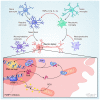Recent advances in preventing neurodegenerative diseases
- PMID: 35028646
- PMCID: PMC8725650
- DOI: 10.12703/r/10-81
Recent advances in preventing neurodegenerative diseases
Abstract
The worldwide health-care burden of neurodegenerative diseases is on the rise-a crisis created through a combination of increased caseload and lack of effective treatments. The limitations of pharmacotherapy in these disorders have led to an urgent shift toward research and clinical trials for the development of novel compounds, interventions, and methods that target shared features across the spectrum of neurodegenerative diseases. Research targets include neuronal cell death, mitochondrial dysfunction, protein aggregation, and neuroinflammation. In the past few years, there has been a growth in understanding of the pathophysiologic mechanisms of neurodegenerative disorders such as Alzheimer's disease, Parkinson's disease, amyotrophic lateral sclerosis, multiple sclerosis, and Huntington's disease. This increase in knowledge has led to the discovery of numerous novel neuroprotective therapeutic targets. In this context, we reviewed and summarized recent advancements in neuroprotective strategies in neurodegenerative diseases.
Copyright: © 2021 Dawson TM et al.
Conflict of interest statement
TMD and VLD own stock options in Inhibikase Therapeutics Inc., are founders of and hold an ownership equity interest in Valted LLC, are inventors of technology of Neuraly Inc. that has been optioned from Johns Hopkins University, and are founders of and hold shares of stock options and equity in Neuraly Inc., which is now a subsidiary of D&D Pharmatech. TMD and his spouse hold shares of stock options and equity in D&D Pharmatech and are founders of and hold equity in Valted Seq Inc. TMD is the Leonard and Madlyn Abramson Professor in Neurodegenerative Diseases. These arrangements have been reviewed and approved by Johns Hopkins University in accordance with its conflict-of-interest policies. The other authors declare that they have no competing interests.No competing interests were disclosed.No competing interests were disclosed.
Figures

References
Publication types
LinkOut - more resources
Full Text Sources
Miscellaneous
